How to future-proof your email marketing with BIMI, AMP and AI
Stay ahead of the curve by modernizing your email strategy with BIMI, AMP for Email, and AI. Learn how to improve deliverability, boost engagement, and personalize at scale.
Email remains one of the highest-performing marketing channels, but inbox competition is intense. More than 340 billion emails are sent every day, and customer expectations are higher than ever.
You need secure, relevant email marketing campaigns that build trust and earn engagement, reaching the right people at the right time.
In this guide, we’ll break down how to future-proof your email marketing strategy using Brand Indicators for Message Identification (BIMI), Accelerated Mobile Pages (AMP), and AI personalization to stay competitive now and in the future.
If you’re planning your roadmap, these innovations can help you boost results across all your campaigns.
Why ‘future-proofing’ matters in email marketing
Email marketing is evolving. Security requirements are tightening, privacy expectations are rising, and new technologies are changing how we reach new customers (and nurturing relationships with existing loyal customers).
Even so, email continues to deliver results. According to Omnisend’s 2025 Marketing Report, email open rates rose 6% and click-to-conversion rates jumped 27.6% year-over-year in 2024.
That’s a strong signal that customers are still engaging. Email remains one of the most reliable ways to build relationships and drive revenue, even as other channels become harder to measure or scale.
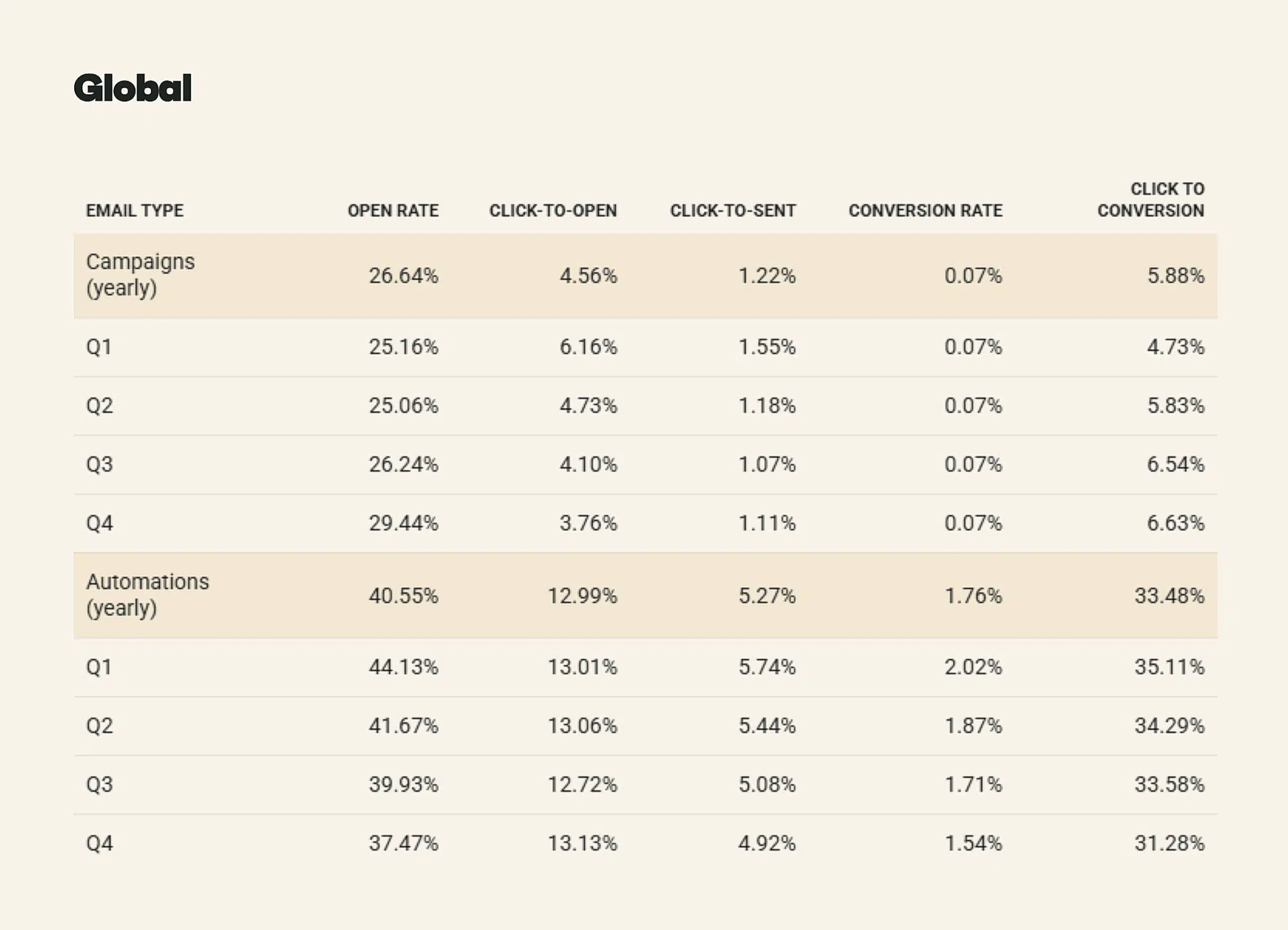
Image source: Omnisend
Marketers today need to navigate three major shifts:
- Privacy regulations and browser changes are reducing access to third-party data.
- Deliverability is harder to maintain as inbox providers block unauthenticated senders.
- Customers expect emails to be personalized, timely, and relevant to their needs.
Future-proofing means planning for these realities now, so your email marketing efforts can continue to work as the landscape evolves.
Why third-party data is declining and how email fills the gap
The shift away from third-party cookies (3PC) and tracking is changing how marketers engage customers. Regulations such as GDPR and CCPA, combined with browser-level changes, are limiting the collection of behavioral data.
After Apple’s iOS 14.5 update, 96% of users opted out of third-party tracking. Safari and Firefox already block 3PCs by default, and Chrome is on track to follow. These changes make it more challenging to target ads or build accurate customer profiles.
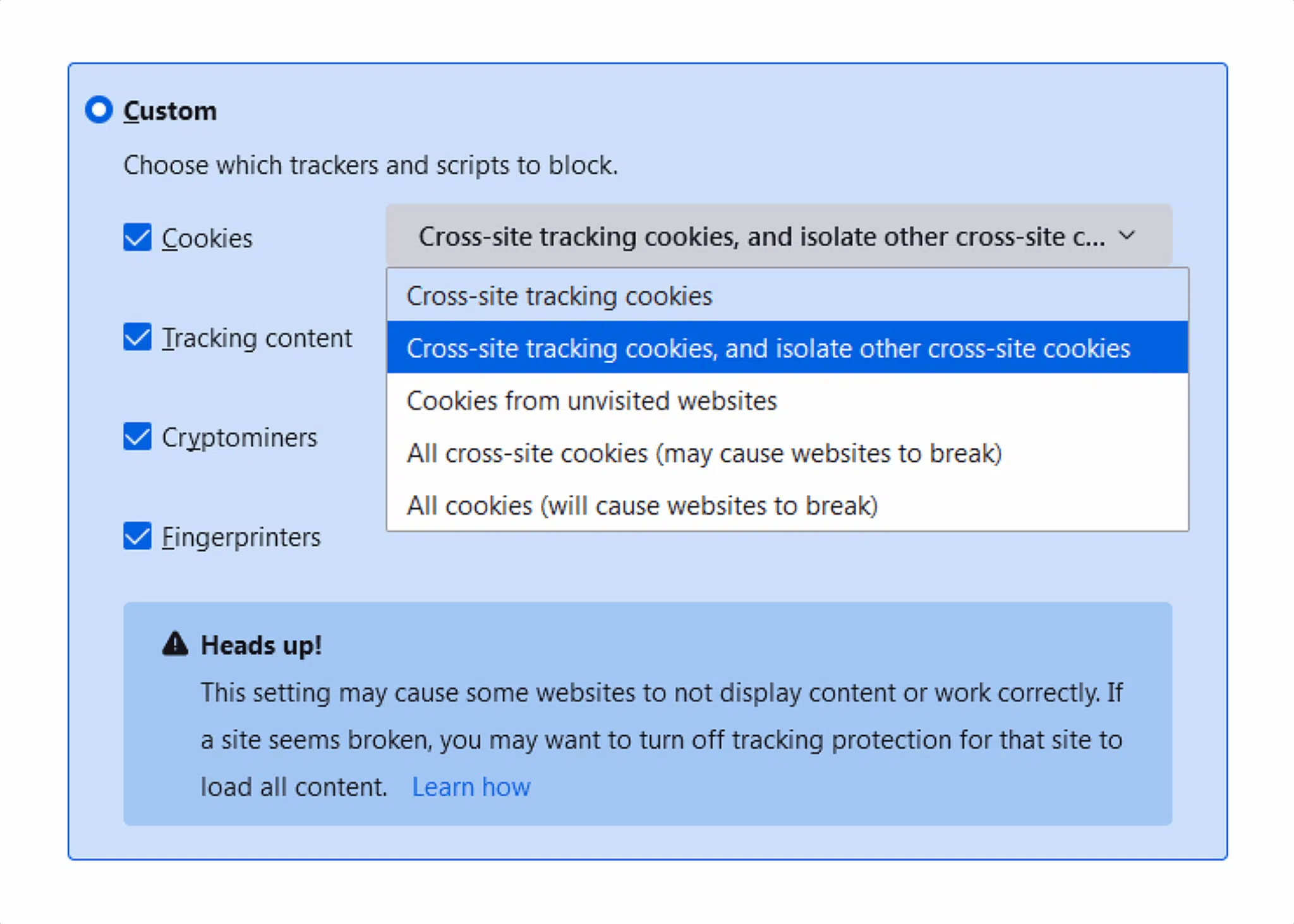
That’s where email steps in. Unlike third-party data, email relies on first-party data—information your audience shares with you directly. It’s permission-based, measurable, and built on trust.
But email also brings its own challenges.
Rising security concerns demand authentication
Email continues to be one of the most common entry points for cyber threats. Phishing attacks, spoofing, and impersonation attempts are on the rise, making inbox security a top priority for both providers and recipients.
Inbox providers are responding by tightening email deliverability filters and enforcing stricter authentication requirements. Messages from unauthenticated senders are more likely to be rejected, flagged, or routed to spam.
To stay in the inbox, brands need to implement:
- Sender Policy Framework (SPF): Verifies that the email is sent from an authorized server.
- DomainKeys Identified Mail (DKIM): Adds a digital signature to verify the sender’s identity.
- Domain-based Message Authentication, Reporting, and Conformance (DMARC): Aligns SPF and DKIM and instructs inbox providers on how to handle messages that fail.
Add visual identity cues like BIMI, and you give users one more reason to trust your message. BIMI lets brands display their logo directly in supported inboxes, reinforcing legitimacy at a glance.
These protocols enhance deliverability, protect your brand, foster trust with subscribers, and ensure your emails comply with modern sending standards.
Customers are cautious, but trust can be earned
Privacy is top of mind for consumers. Data privacy and security rank second only to the cost of living as Americans’ biggest concerns. That anxiety directly impacts how people engage with email.
A ZeroBounce study found:
- 80% of users mark emails as spam if they “look like spam”
- 55% will report an email as spam if they didn’t opt in
- 47% will complain if there’s no unsubscribe link
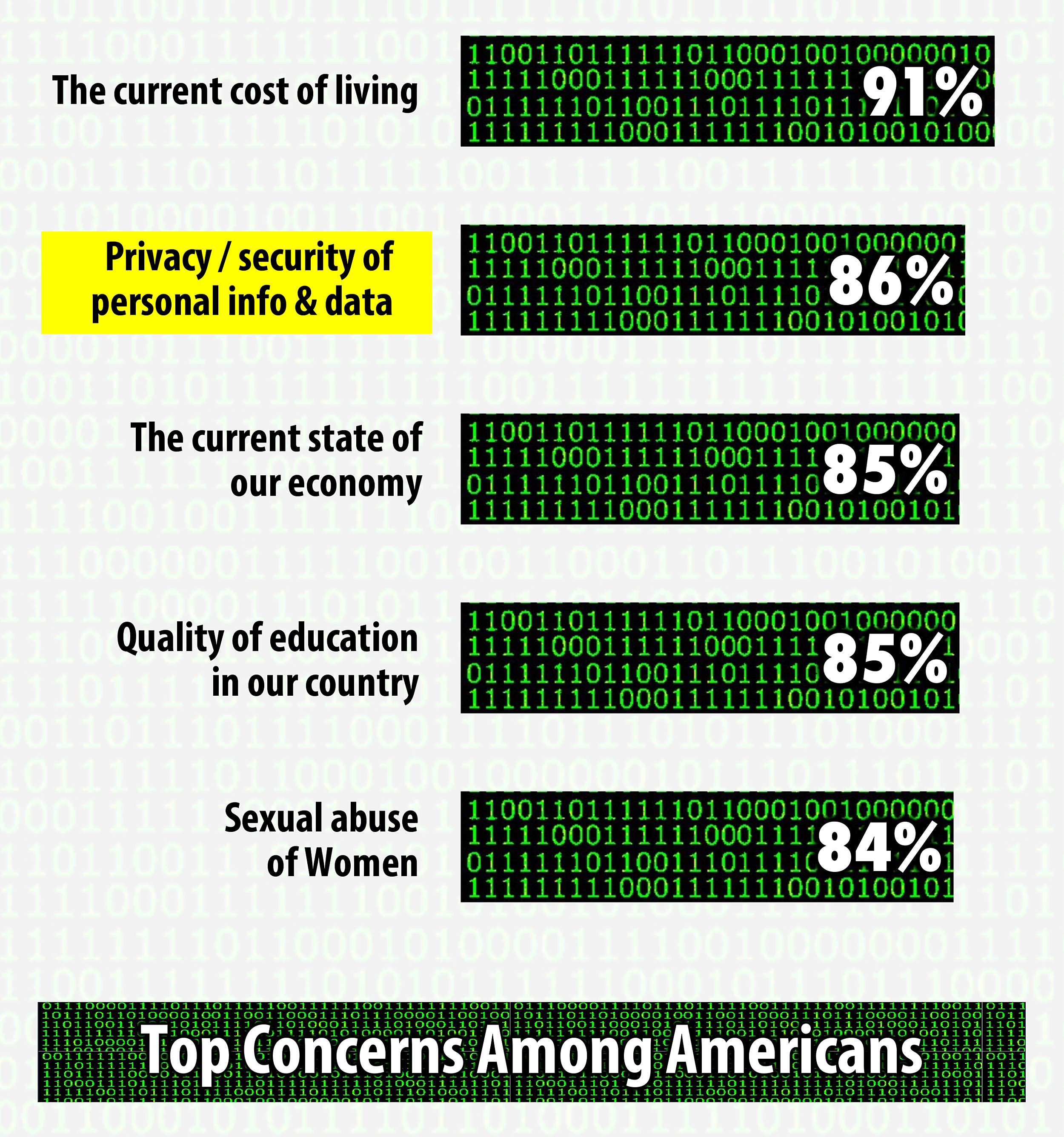
Image source: Publishers Clearing House
Email attacks, such as phishing, continue to rise, targeting individuals and companies alike. Even as awareness grows, users remain cautious, especially if they don’t recognize the sender, feel the message is intrusive, or otherwise find the email content suspicious.
This makes authentication and sender transparency essential for engagement. Brands that follow best practices can stand out, build trust, and increase inbox placement.
Future-proofing starts with trust, relevance, and scale
The most resilient email strategies combine authentication, personalization, and engagement, all of which are powered by first-party data that positively reinforce relationships with email subscribers.
To build an email program that’s ready for the future, focus on three high-impact tactics:
- Use BIMI to establish visual trust with recipients
- Add AMP components to make emails interactive and frictionless
- Leverage AI to personalize content, timing, and offers at scale
These tactics don’t require invasive tracking. They’re powered by the data your audience chooses to share, and they help you build lasting relationships while staying compliant.
Implementing BIMI for brand trust and deliverability
Brand Indicators for Message Identification (BIMI) is an email authentication standard that displays your verified logo alongside messages in supported inboxes, like Gmail and Yahoo. When properly configured, it improves brand visibility, boosts engagement, and builds trust with new subscribers.
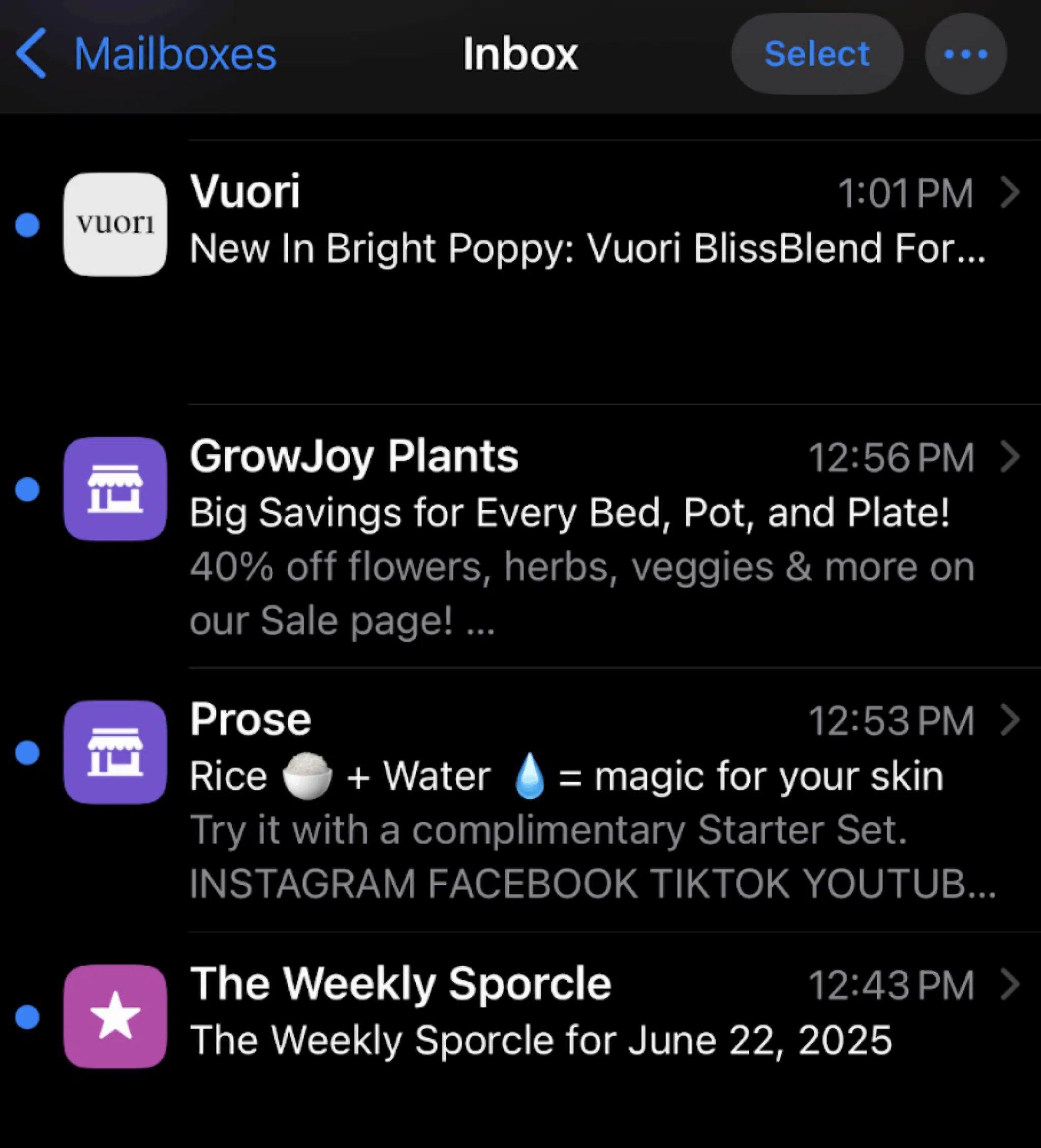
BIMI only works when your domain has implemented SPF, DKIM, and DMARC authentication. Specifically, you’ll need a DMARC record set to enforcement (quarantine or reject) and a verified logo hosted securely.
Note: DMARC builds on SPFders how to handle messages that fail authentication. Without DMARC, BIMI won’t display even if SPF and and DKIM by instructing inbox proviDKIM are valid.
How BIMI can improve email marketing performance
We’ve already covered how BIMI builds trust and visibility by displaying your verified logo next to authenticated messages. But what does that actually mean for performance?
A study by Red Sift and Entrust found that BIMI implementation led to:
- 90% increase in consumer confidence in email legitimacy
- 21% increase in open rates
- 18% boost in brand recall after just five seconds of exposure
While BIMI doesn’t directly determine inbox placement, higher engagement and lower spam reports can improve sender reputation over time, leading to better deliverability and stronger campaign performance.

How to set up BIMI
Setting up BIMI requires collaboration between your design, marketing, and IT teams. Here’s a step-by-step guide:
Step 1. Confirm DMARC enforcement
If you haven’t already implemented DMARC, start there. BIMI requires at least 30 days of DMARC enforcement (p=quarantine or p=reject).
Check your current DMARC policy using tools like MxToolbox or DMARC Analyzer. BIMI requires DMARC authentication at the enforcement level (p=quarantine or p=reject).
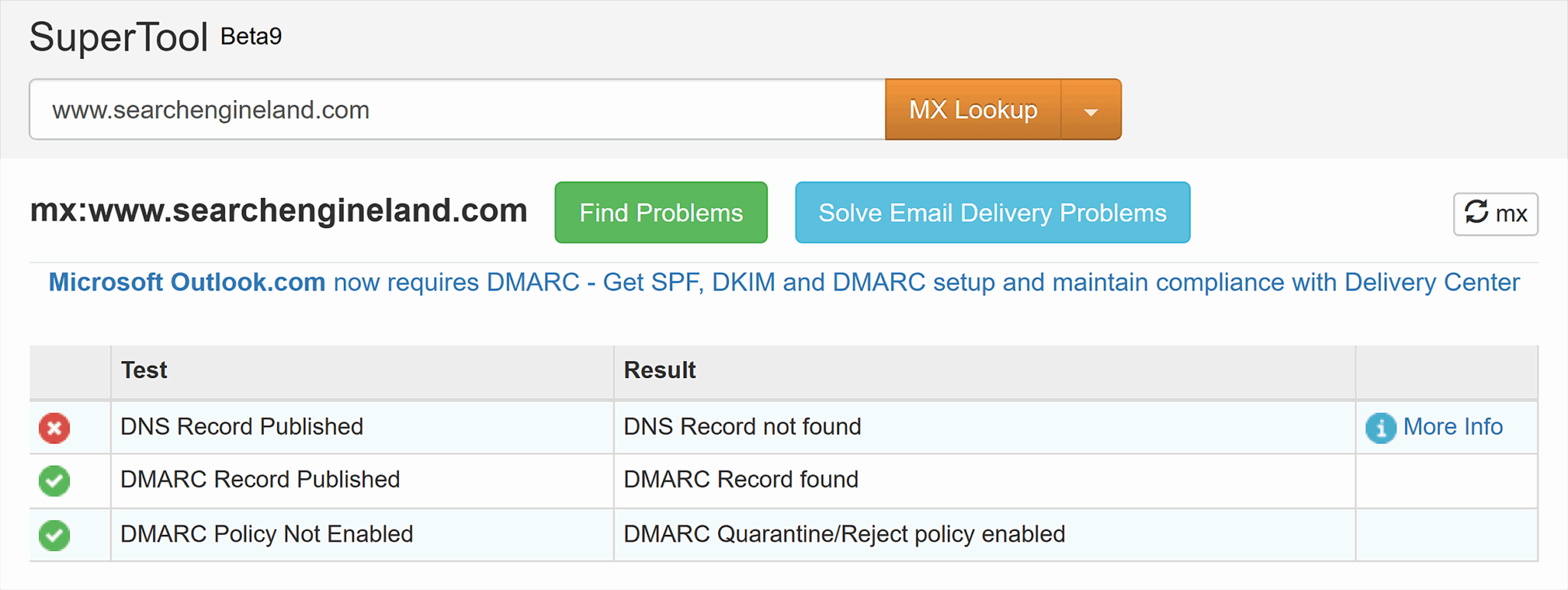
Step 2. Prepare your logo
Design a logo file in the SVG Tiny Portable/Secure (SVG P/S) format. This is the format inboxes require for BIMI. Requirements include:
- Square aspect ratio
- File size under 2MB
- No embedded scripts or external links
Step 3: Add BIMI record to DNS
Next, publish a BIMI TXT record in your DNS settings. This record informs inbox providers where to find your logo and confirms the verification of your domain.
Step 4: Testing and monitoring
Use tools like Valimail or Mailkit to double-check that your logo appears correctly in supported inboxes.
Pro tip: Monitor your sender reputation and engagement through your ESP or deliverability platform. BIMI works best when paired with consistent authentication and list hygiene practices.
How to use AMP for interactive, high-engagement emails
Accelerated Mobile Pages (AMP) for email transforms static messages into interactive experiences packed with customer engagement. Customers can scroll through image carousels, submit reviews, and browse products with real-time pricing, all without leaving their inbox.
How AMP can improve UX
AMP for email brings interactive experiences directly into the inbox. Instead of sending users to another website, AMP enables them to take action directly within the email. This removes friction, increases engagement, and creates a more dynamic customer experience.

Here are examples of how AMP can enhance different parts of the customer journey:
- Interactive surveys: Let users provide feedback or complete multi-question surveys directly within the email
- Dynamic carousels: Allow users to swipe through multiple products, services, or content options
- Real-time content updates: Automatically update pricing, inventory, or recommendations when the email is opened
- In-email transactions: Enable users to complete purchases or submit forms directly within the message
- Accordion and FAQ sections: Help readers explore more without overwhelming them with too much text at once
Here’s a breakdown of the most useful AMP components and how they improve UX:
| Type of AMP component | Purpose | UX improvement |
| Interactive surveys | Collect customer feedback and data | Reduces friction for users to take action |
| Dynamic carousels | Let users browse multiple products or services | Creates an engaging, swipeable experience |
| Real-time content updates | Display current prices or stock availability | Provides timely, accurate information |
| In-email transactions | Support purchases and form submissions | Streamlines the customer journey |
| Accordion and FAQ sections | Expandable content for more detail | Helps prevent information overload |
How to add AMP components to your email campaigns
There are two ways to add AMP components to your emails: use custom code or choose a tool with built-in AMP support.
If you don’t have developer support, platforms like Stripo.email, Mailmodo, and Mailercloud offer ready-made AMP templates. These tools make it easier to add AMP features without writing code, though customization is more limited.
Example: Using Stripo.email
Step 1: Create a new email campaign. You can either start from scratch or choose a template.
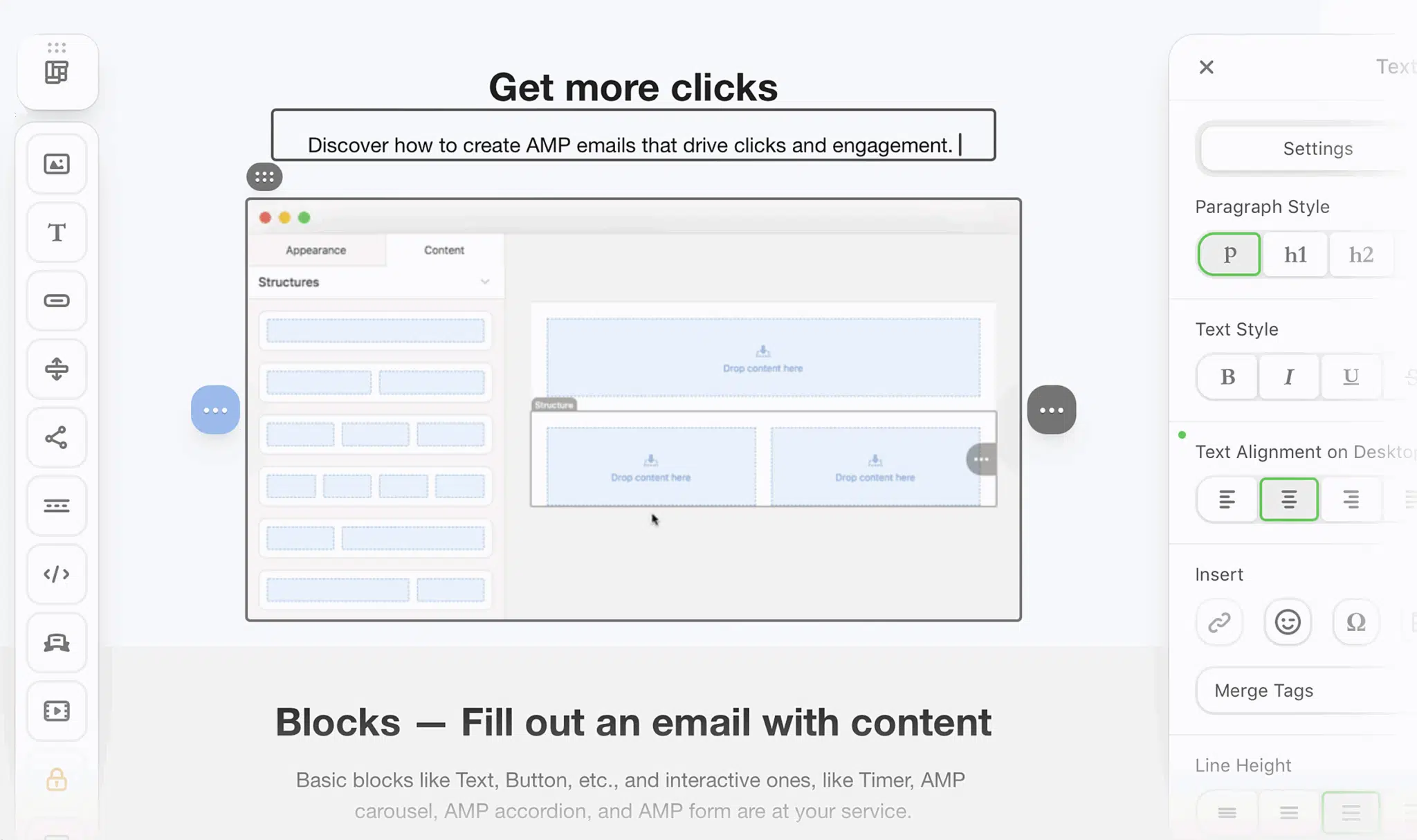
Step 2: On the left-side toolbar, you can find various AMP options, including carousels, AMP forms, and AMP accordions. Choose the component you want to add to your campaign.
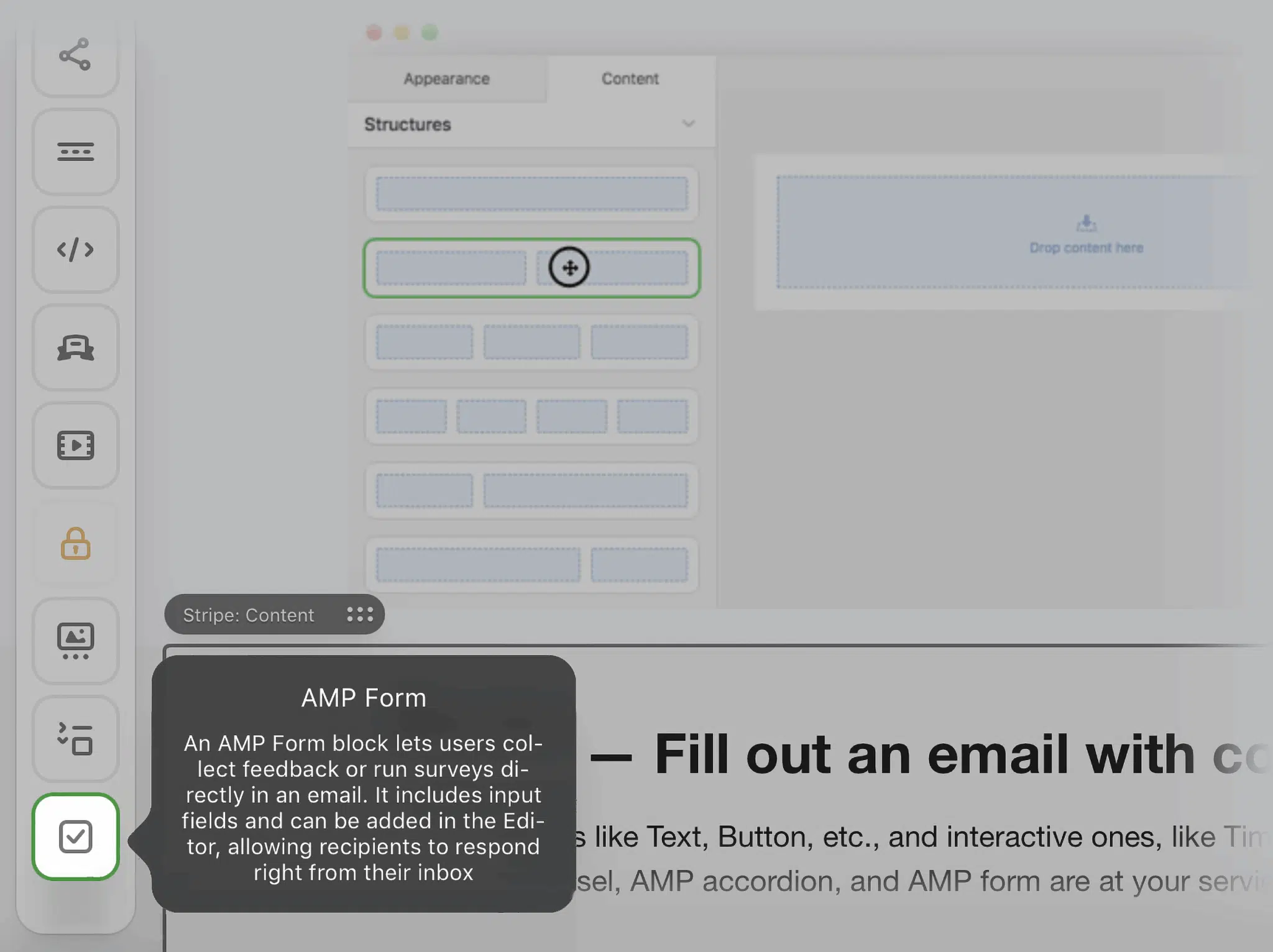
Step 3: Click and hold on the component you want to add to your email. Drag it to the desired location in the template.

Step 4: Customize the component. In this example, we added copy to the label and placeholder text fields to prompt users to leave a review.
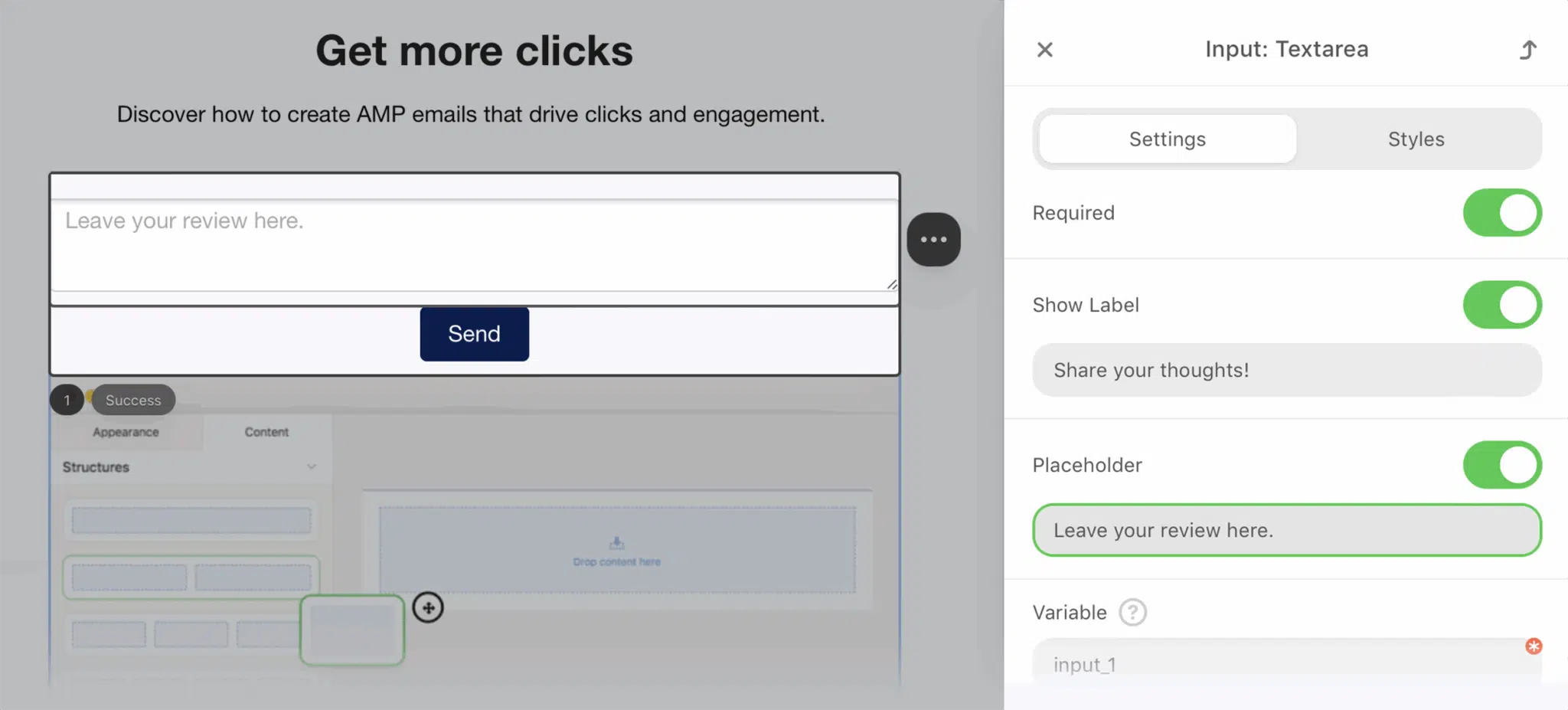
Step 5: Use desktop and mobile previews to review your campaign and the AMP feature before you send it.
AMP limitations and fallback requirements
To use AMP effectively, marketers need to account for its current limitations and plan for reliable fallback content.
- Supported clients: Gmail, Yahoo Mail, Mail.ru, and select other providers support AMP components. Not all email providers do.
- Fallback requirements: Every AMP email should include traditional HTML and text versions to ensure deliverability across all inboxes.
- Security restrictions: AMP content must meet strict security standards. Dynamic elements must be served from verified, approved sources.
AMP vs. traditional responsive design: How to choose
While AMP boosts UX by making emails interactive (as covered above), it isn’t always the best fit for every campaign. Choosing between AMP and traditional responsive design depends on your specific goals, target audience, and available resources.
Choose AMP when:
- You want users to take action without leaving the email (e.g., submit surveys, browse products, make purchases)
- Real-time updates (like pricing or availability) enhance campaign value
- Your audience uses Gmail, Yahoo Mail, or other AMP-supported inboxes
- You have the tools or dev resources to implement and maintain AMP
For example, the email below from Stitch Fix uses AMP. When users open the email, they see a “Personalizing” loading wheel.

Then, they’ll see items selected based on their style preferences that are currently available in their size and budget. This personalization is a strong value add, showing relevant items to each customer.

Use traditional responsive design when:
- You’re focused on straightforward campaigns that prioritize readability
- Your audience relies on inboxes that don’t support AMP features
- The interactive component doesn’t meaningfully improve UX or CTR
- You lack the time or resources to implement and QA AMP elements
Let’s say you’re writing a promotional email. Evaluate whether the carousel AMP feature will actually enhance the customer experience and increase the click-through rate (CTR). In some cases, using separate, static product images would yield the same end result.
In the example below, Stitch Fix opts for a standard responsive email template rather than using AMP features. The static images are effective for this campaign. It features a specific look instead of making personalized recommendations.

Using AI tools to personalize emails at scale
AI-powered email marketing tools enable teams to create more targeted campaigns that drive higher engagement, retention, and conversion rates. Customers expect this level of personalization.
In a recent McKinsey study, 71% of customers reported that they expect personalized experiences and are more likely to purchase from brands that provide them.
Modern platforms make this possible by using real-time data to optimize subject lines, content, recommendations, and send times. The right tool allows marketers to scale personalization without increasing manual effort.
AI capabilities to look for:
- Personalized email subject lines and dynamic content
- AI-generated product recommendations
- Smart send-time optimization based on user engagement
- Automated A/B testing for continuous improvement
Here’s what leading AI tools offer:
Jasper
Jasper is an AI content creation platform that generates personalized subject lines, email copy, and calls-to-action based on customer data and brand voice guidelines.
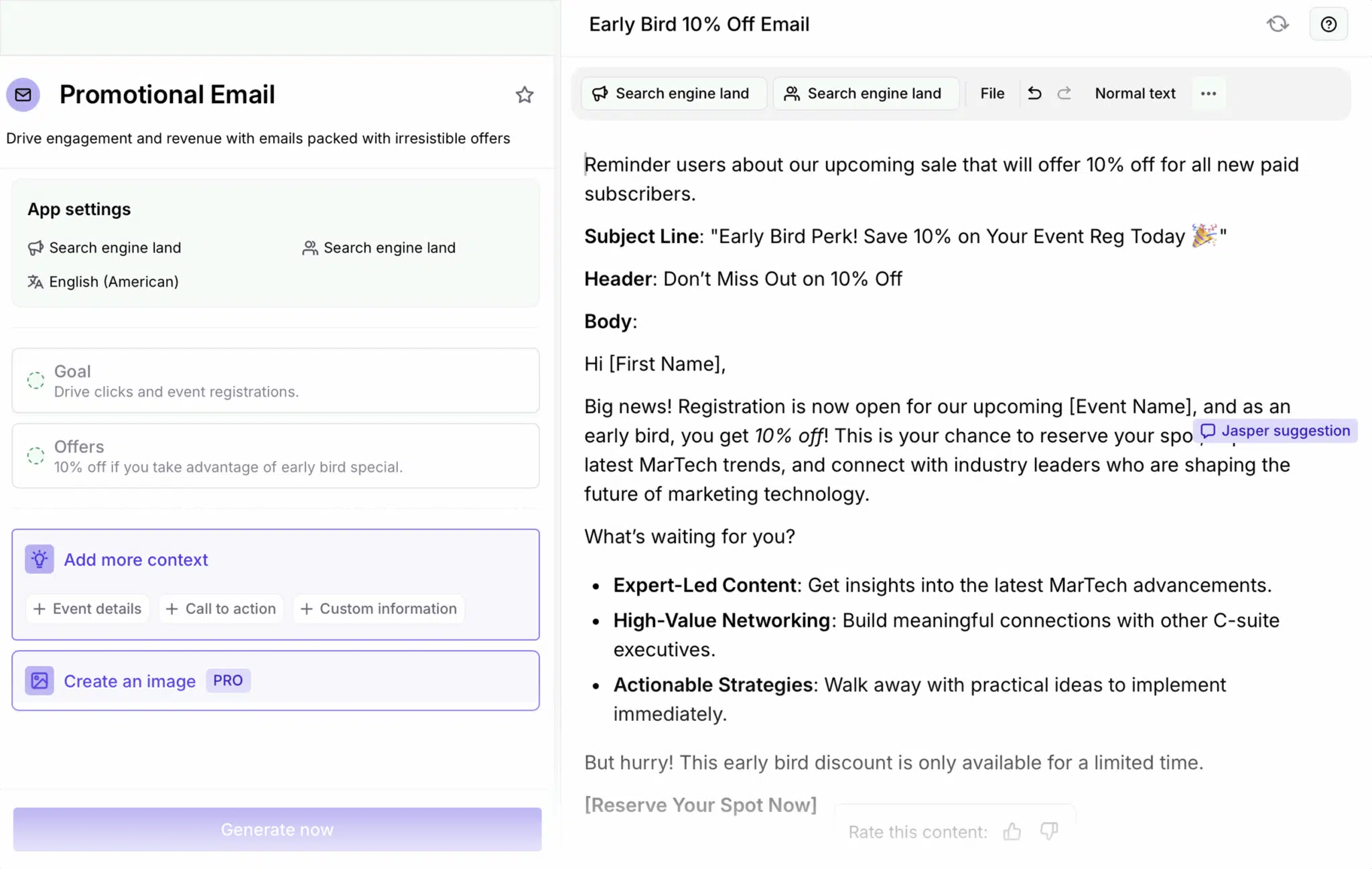
Key features include:
- Brand voice training for consistent messaging across campaigns
- Dynamic content generation based on advanced customer segments and behavior
- A/B testing capabilities for AI-generated content optimization
- Integration with major ESP platforms for seamless workflow integration
- Template customization for different campaign types and industries
Brevo AI
Brevo offers a comprehensive email marketing platform with built-in AI for send-time optimization, subject line generation, and behavioral trigger automation.

Key capabilities include:
- Machine learning send-time optimization for individual recipients.
- Automated segmentation based on engagement behavior and preferences.
- Dynamic content blocks that update based on recipient data and interactions.
- Predictive analytics for campaign performance and optimization recommendations.
- Automated A/B testing for continuous improvement.
Klaviyo AI
Klaviyo AI is an advanced email marketing platform with sophisticated AI-driven personalization and predictive analytics. It’s specifically designed for email marketing by ecommerce brands.
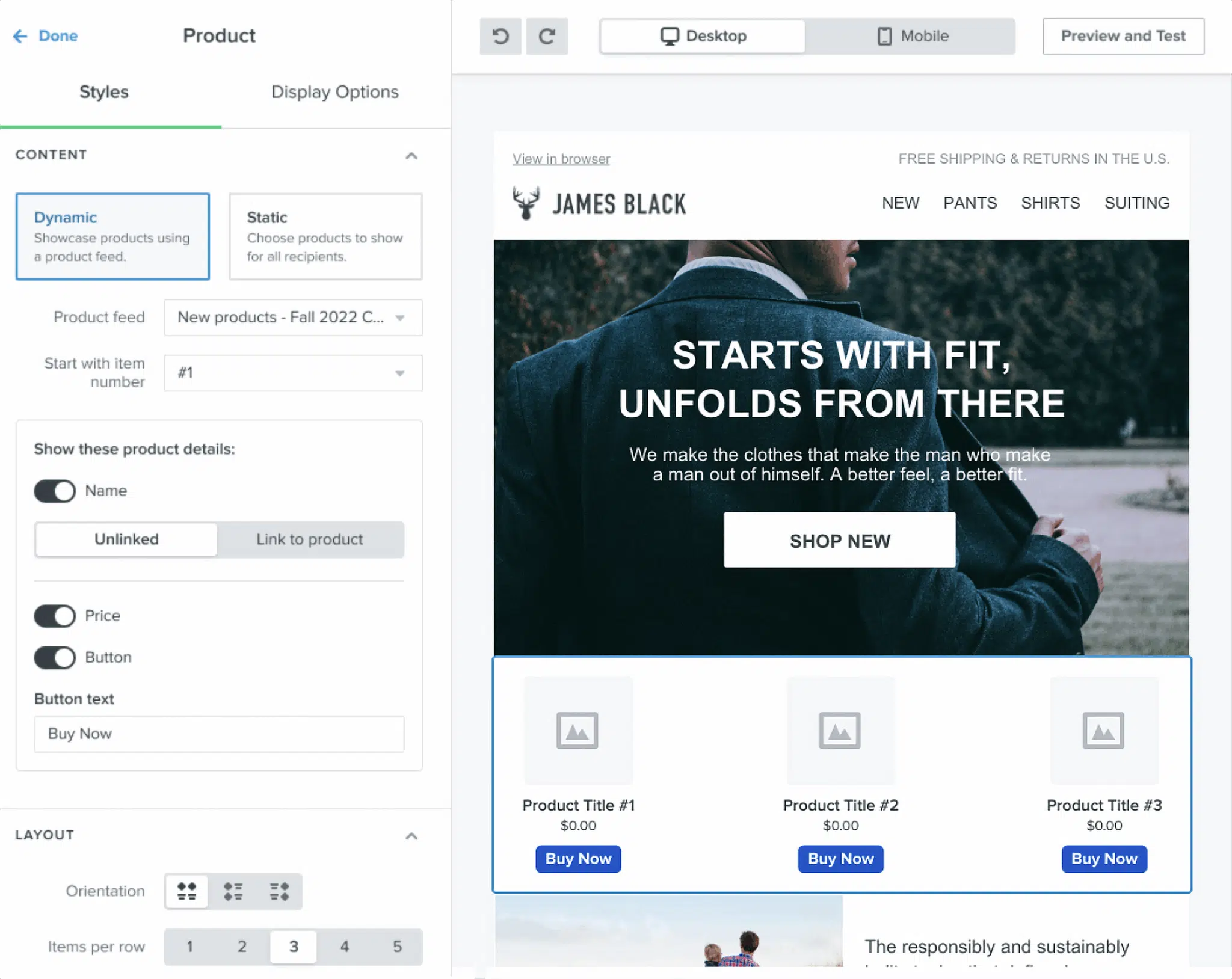
Key capabilities include:
- Predictive analytics that forecast customer lifetime value and churn risk.
- AI-powered product recommendations that update in real-time based on inventory and customer behavior.
- Smart send-time optimization that learns individual engagement patterns.
- Dynamic content blocks that automatically personalize based on customer data.
Your Competitors Are Already Tracking Their AI Search Visibility—Are You?
✓ See exactly where competitors appear in ChatGPT, Perplexity, and Gemini
✓ Compare your AI search share of voice vs. top 5 competitors
✓ Identify AI visibility gaps you can capture this quarter
Built for enterprise martech stacks
Setting guardrails to keep AI on track
Establishing controls for brand consistency, regulatory compliance, and quality assurance ensures that automated systems remain on target when creating copy.
AI can make mistakes ranging from using off-brand phrasing to hallucinating information entirely, but setting up guardrails can reduce the risk of inaccurate or off-brand content going live.
Marketing teams can maintain better output quality and brand compliance with guardrails and processes such as:
- Brand voice consistency: Train AI models using approved brand content, tone guidelines, and example messaging
- Compliance oversight: Implement human review processes for campaigns in regulated industries or those involving sensitive topics
- Quality control measures: Use automation to scan for errors, spam triggers, and alignment with brand rules
- Human oversight protocols: Keep a human in the loop for high-stakes campaigns or new AI features
- Performance monitoring: Compare AI content results to human-created campaigns to fine-tune your systems
Many AI-native tools have guardrail features. In the example below, you can see Jasper’s brand voice feature that helps the platform write according to your specifications.
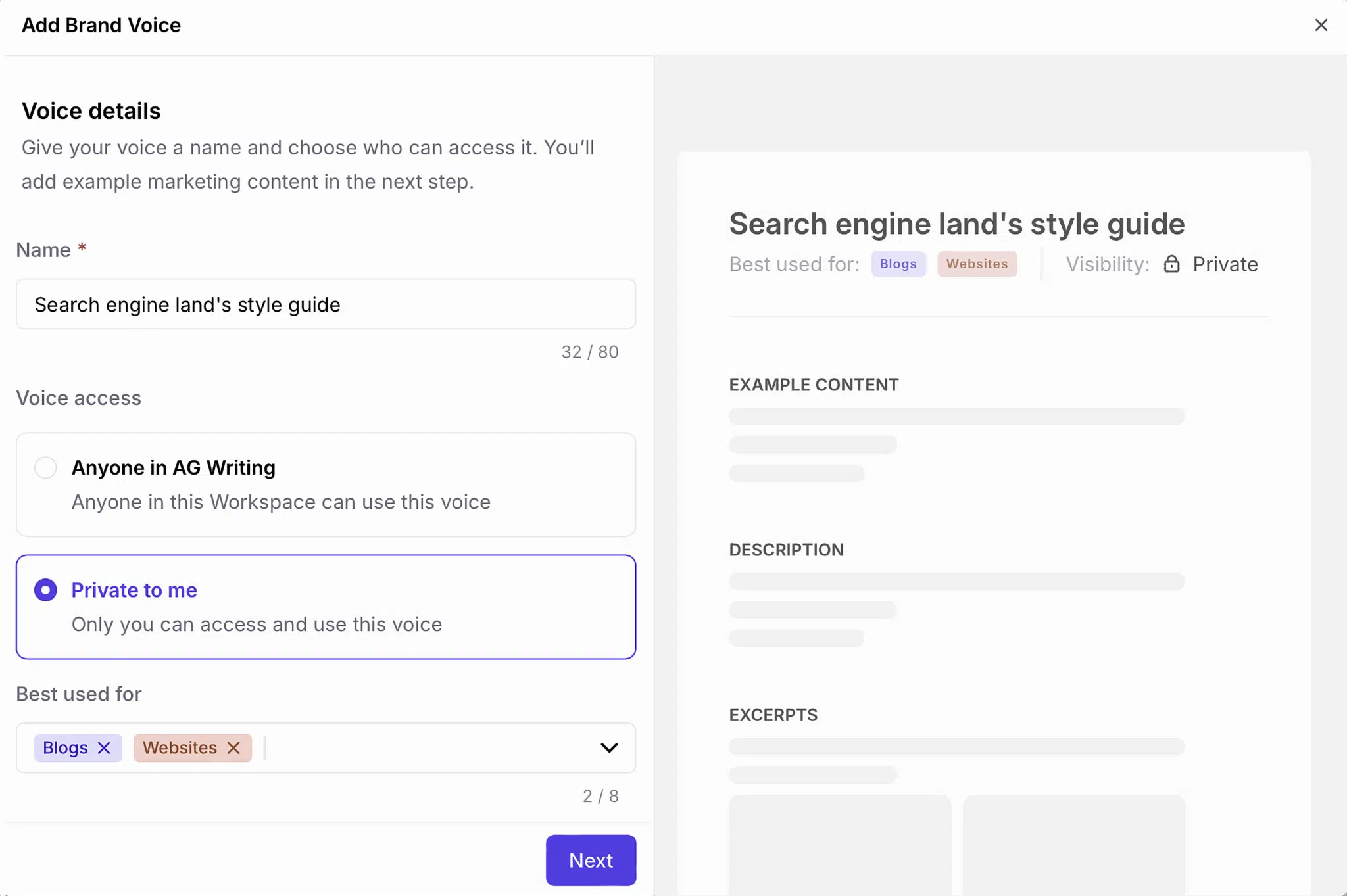
Integrating these tactics into your email ecosystem
Incorporating these advanced new tactics into your email strategy may require integrating new tools into your existing tech stack. You’ll also want to have a clear roadmap to adopt and implement new tools so you can balance fast, cost-effective wins and long-term objectives.
Integrating new tools with your martech stack
Your marketing technology stack needs to support advanced email features and provide the data integration necessary for effective personalization and authentication. Let’s discuss what to look for.
Email Service Provider (ESP) requirements
Choose platforms that natively support BIMI, AMP, and AI features. Third-party integrations can be effective, but they may have more limited features or more complex implementation processes than AI-native tools.
Customer Data Platform (CDP) integration
Ensure your CDP can feed real-time customer data to your ESP for AI personalization and dynamic segmentation. Look for platforms with robust API connections and real-time data sync capabilities.
CRM alignment
Connect your CRM system to enable behavioral triggers, lifecycle marketing, and seamless alignment between sales and marketing. AI personalization works best when it has access to the complete history of customer interactions.
Data flow architecture
Establish automated data pipelines between platforms to ensure AI personalization has access to current customer information, like purchase history and engagement data.
To revamp your strategy, you’ll need to adopt new tools and integrate them into your existing tech stack. Then test their features to see what delivers the most significant impact. Begin by implementing authentication and AI fundamentals before advancing to interactive features and long-term optimization.
Here’s a roadmap of what that may look like:
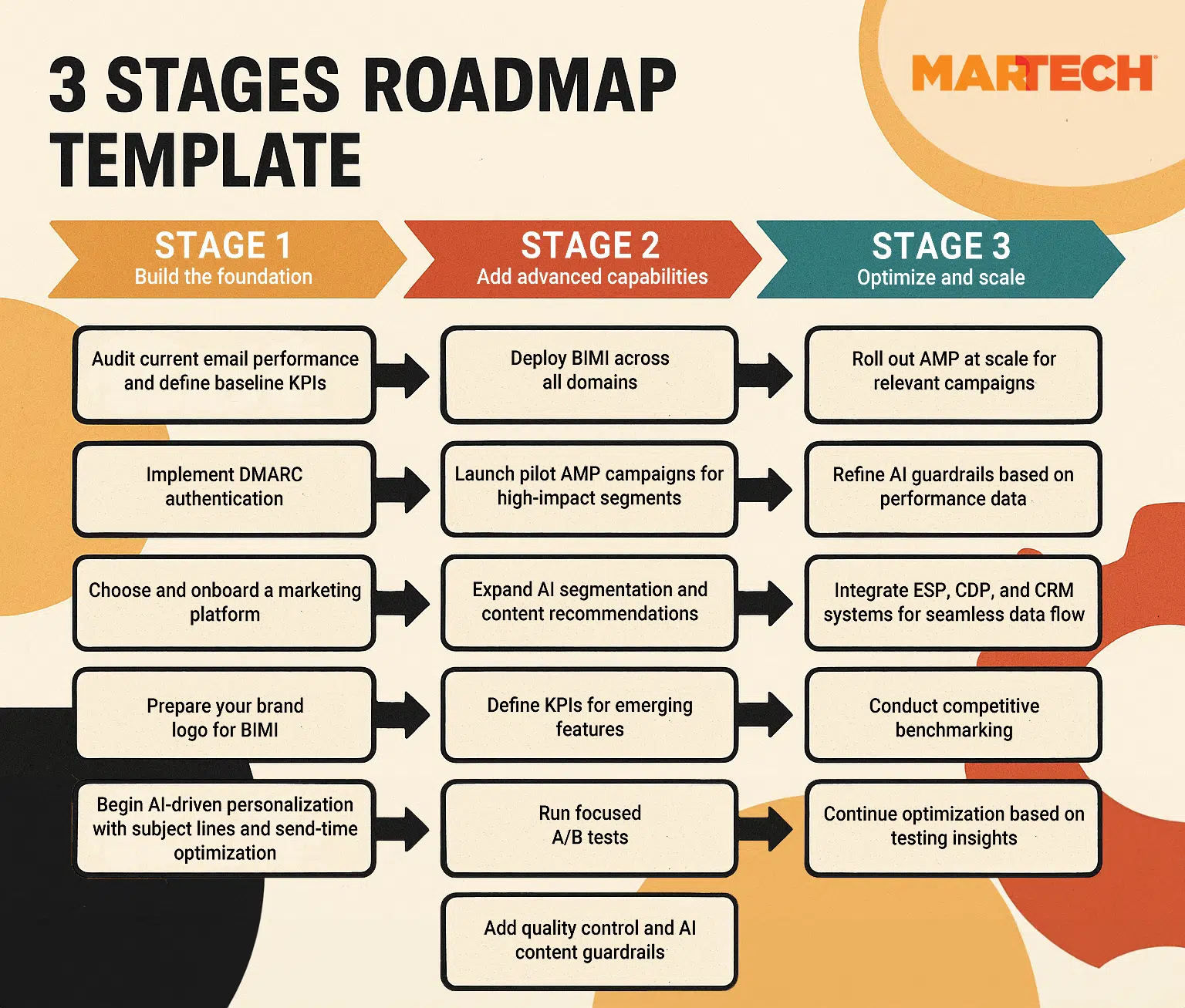
Stage 1: Build the foundation
- Audit current email performance and define baseline KPIs
- Implement DMARC authentication
- Choose and onboard a marketing platform
- Prepare your brand logo for BIMI
- Begin AI-driven personalization with subject lines and send-time optimization
Stage 2: Add advanced capabilities
- Deploy BIMI across all domains
- Launch pilot AMP campaigns for high-impact segments
- Expand AI segmentation and content recommendations
- Define KPIs for emerging features
- Run focused A/B tests
- Add quality control and AI content guardrails
Stage 3: Optimize and scale
- Roll out AMP at scale for relevant campaigns
- Refine AI guardrails based on performance data
- Integrate ESP, CDP, and CRM systems for seamless data flow
- Conduct competitive benchmarking
- Continue optimization based on testing insights
How to test and optimize your email marketing changes
Dedicated A/B testing, focused on KPIs that align with your business objectives, is essential for assessing and optimizing changes to your marketing strategy.
Intentional testing can help your team determine:
- Which technology, strategies, and features are working
- Which new tactics are improving key performance metrics with your target demographics
- How to make changes and optimize existing campaigns for improved performance moving forward
Run A/B tests to measure impact
A/B testing involves testing a single variable at a time, which helps you assess how a single feature, such as an AMP component or a dynamic subject line, actually impacts performance.
You can test whether different types of AMP elements are driving specific actions, for example. Or, you could determine whether AI-generated subject lines get better results than human-created counterparts.
These are the A/B testing priorities to consider:
- Assess BIMI’s impact on open rates and brand recognition
- Track AMP interactive elements vs. traditional call-to-action buttons, clicks, and conversion rates
- Monitor AI-generated content performance vs. human-created campaigns
Some tools have native A/B testing functionality and special features to speed up the process.
For example, Mailchimp allows you to test multiple versions of a single variable, such as a subject line or email body copy, for direct comparison of different versions of your campaign.
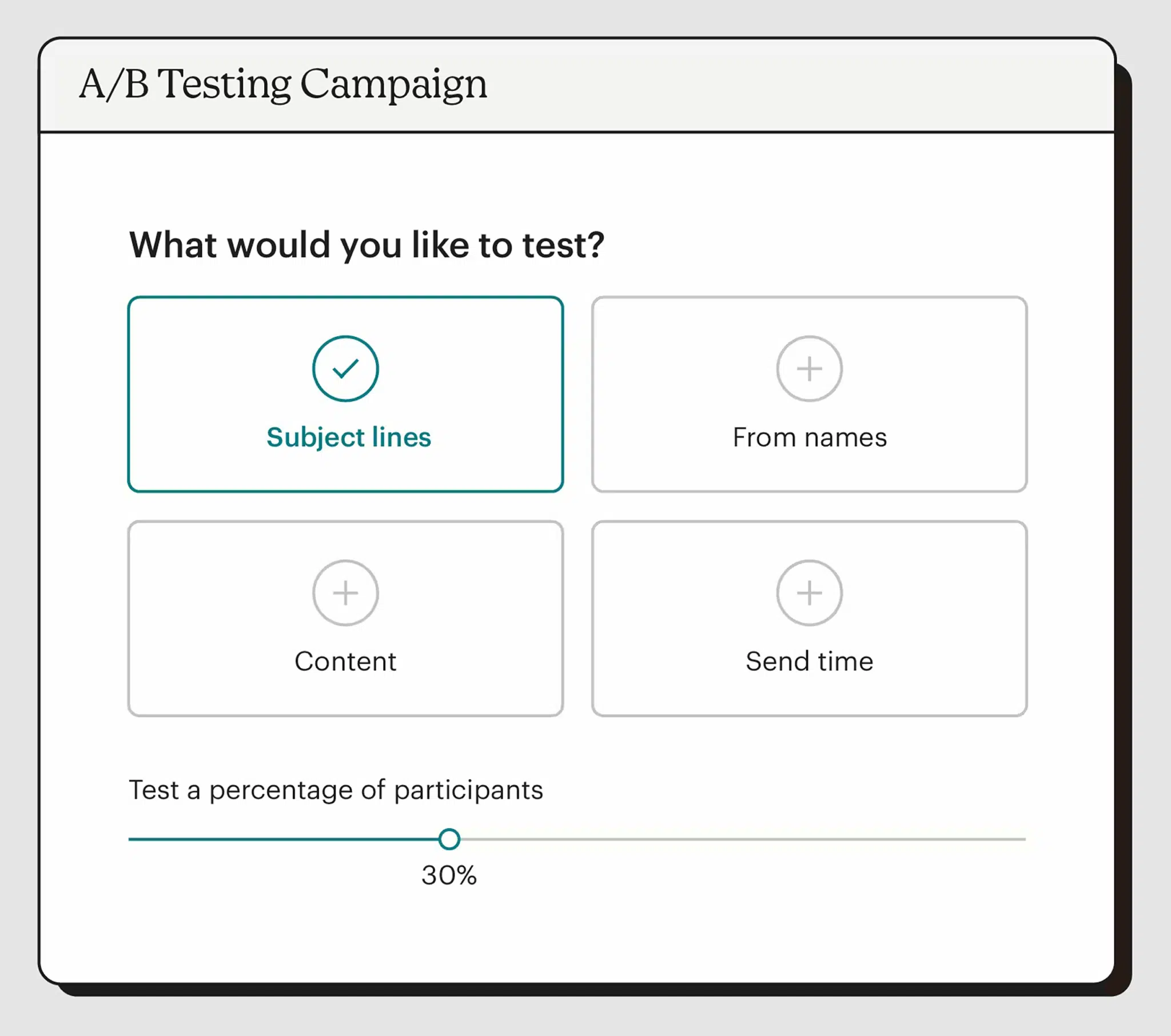
Track KPIs that align with business goals
When running A/B tests on specific features and tracking overall campaign performance, monitoring the right KPIs can help you determine which tactics are most effective.
BIMI-specific metrics:
- Inbox placement rates
- Open rates
- Brand recall surveys
- Spam complaint rates
AMP engagement metrics:
- Time spent in email
- In-email conversion rate
- Click-to-external-site rate
- Interaction rate with AMP components (carousels, accordions, forms)
AI personalization performance:
- Open rate improvements from AI-generated subject lines
- Revenue per recipient by segment
- Engagement by send-time optimization
- Click-through rates from product recommendations
Overall campaign health:
- Email-attributed revenue
- Customer lifetime value
- Engagement rates (clicks, opens)
- Unsubscribe rates
Pro tip: Tracking KPIs can help you determine which features, tools, and strategies are working and how to optimize them. Continual improvement processes may include:
- Monthly performance reviews with your email marketing team that assess performance for individual features.
- Quarterly assessment of new features and capabilities.
- Regular testing of AI-generated content quality.
- Ongoing monitoring of authentication and deliverability metrics.
Bring it all together: strategy + tech = long-term wins
Companies that combine cutting-edge email tools and trending strategies that account for customer expectations can see strong results through email marketing.
While technology is advancing rapidly, remember that some foundational best practices are still relevant:
- Test thoroughly: Test all new tools, tactics, and email features across audience segments and device types. Monitor for both technical performance and user engagement.
- Prioritize relevance: Advanced features like AMP and AI personalization only succeed when they deliver genuine value. Focus on use cases where interactivity and personalization directly solve customer problems or streamline their experience.
- Conduct list hygiene: Maintain strict email list hygiene practices. Regularly remove inactive subscribers and implement double opt-in processes to ensure your advanced features reach engaged audiences.
- Review your strategy often: New technology emerges, and consumer expectations shift. Regularly assess your current email marketing strategies to adapt to these changes as they happen to keep running “future-proofed” campaigns.
Email is evolving, but with the right tools, strategy, and testing, you can stay ahead of the curve.
Want more actionable insights like this? Subscribe to our newsletter and get expert-backed strategies delivered straight to your inbox.
New on MarTech